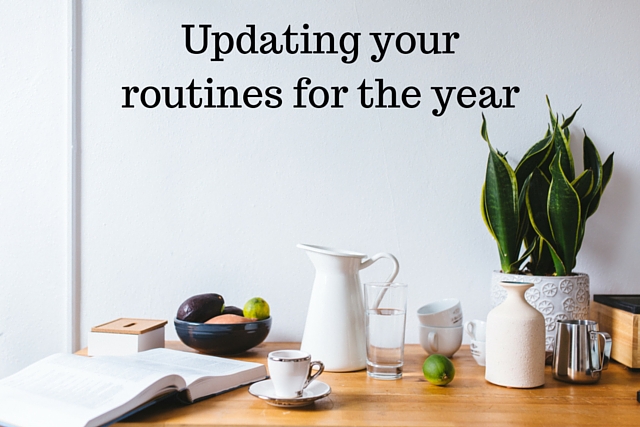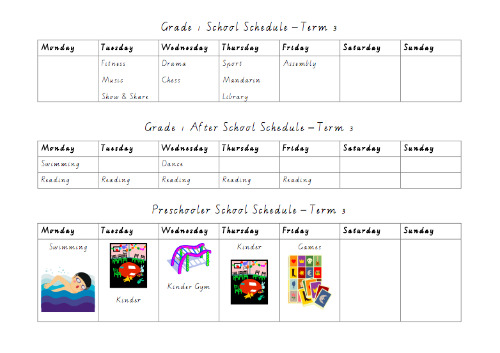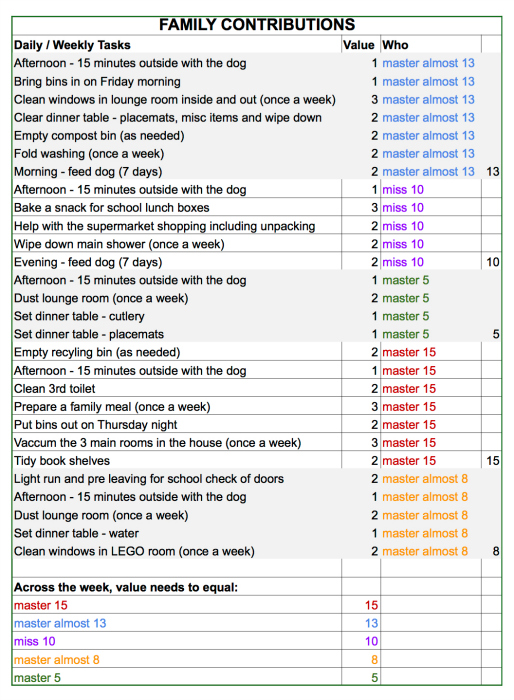Planning is not static. Very rarely can you create a plan and then just leave it. Family life is dynamic so the plans I create to organise the chaos of family life need to be dynamic too.
Some plans need to be updated and changed more than others. Our family budget for example is generally reviewed once a year, but my weekly schedule needs reviewing each term.
I will go through my key plans that I have updated this month to help me stay organised and keep the family on track.
Kids’ schedules
My aim with the kids is to always have them do for themselves what they are capable of. While this approach takes time and effort when teaching them new skills it does pay huge dividends.
The best example of this in our house are the school morning routines. Since our youngest started school a couple of years ago, our mornings are on the whole very calm and organised. This is due mainly to the fact the kids organise themselves. Sometimes kids will need a reminder on something, but once the older three have left the house by 7.40am, there is time for me to play a game with the kids or do some work around the house.
For the younger two I still print out their weekly activities and we still have a getting ready prompt on our notice board as well. The older three manage themselves completely.
You can download templates and find more details on the kids schedules here – Children’s routines
My weekly schedule
I have written previously about decision fatigue. In case you are unaware:
In decision making and psychology, decision fatigue refers to the deteriorating quality of decisions made by an individual, after a long session of decision making. It is now understood as one of the causes of irrational trade-offs in decision making. {source}
Having a weekly schedule doesn’t have to be completely rigid, but by having a framework you can follow for how you will approach the day, it eliminates many tedious but tiring decisions. Minimising the number of small decisions you have to make across the day means you have more mental energy to make the bigger decisions required of you.
It also helps prevent procrastinating over what it is you should actually do. Often we waste so much time just working out where to start. For those of us who work from home and could spend time either in work or home activities at any point across the day, it can be particularly helpful to use a schedule to help us stay focused on the appropriate tasks.
This year I further developed how I put together my schedule:
- I am specific about what I add in first – family based activities, then exercise, my creative time and bed time.
- Work out what are my non work days.
- I have for the first time added in a planning session at the start of the week and a review session at the end of the week.
- Add in my work hours, allocating time to my ONE thing as first priority in the morning.
- Add tasks towards the end of my work day that require less concentrated brain power. For me this is email and social media and by having it at the end of the day before school pick up, it uses a natural boundary that I can’t move to make sure I stick to my time limits.
- I review the schedule to make sure it is not overloaded. While it looks very full, the before and after school routine blocks for example do not have me working solidly that entire time. I just block them out so I have only a sole focus for this time. There is time to sit down and have a cup of tea, ring a friend or share afternoon tea with the kids.
The most important aspect of the schedule is that is my guide. Working from home provides me with fantastic flexibility. If I choose to go for a walk with a girlfriend after school drop off, I will adjust my day accordingly.
I have set appointments in my calendar to correspond with what is in my schedule. This helps me make better decisions about accepting appointments and other commitments. I will try to book meetings in the afternoons away from my “ONE thing” time and by having them in the afternoon there is less chance of them going overtime as I have to leave to pick the kids up.
The schedule for this term is quite different to what I have created before and it is very much influenced by my goal for 2016. There is much more space in the calendar through blocking out chunks of time on key activities like creativity and family time. It will be interesting to see if I can stick to it!
You can download my template for a weekly schedule here – How to create a weekly schedule
Family contribution schedule
As our kids grow older our expectations of what they do around the house increases. The kids can also get sick of completing the same tasks so we find mixing it up on a regular basis works well. We sit down together and work out a new schedule for who is doing what a couple of times a year.
You can download a template of the family contribution schedule here.




